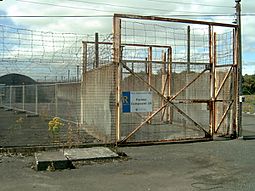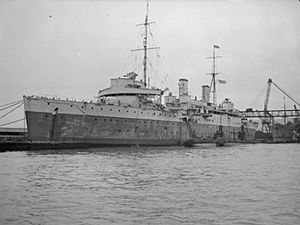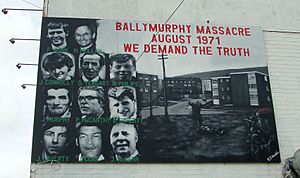Operation Demetrius facts for kids
Quick facts for kids Operation Demetrius |
|
|---|---|
| Part of the Troubles and Operation Banner | |
 The entrance to Compound 19, one of the sections of Long Kesh internment camp |
|
| Location | Northern Ireland |
| Objective | Arrest of suspected Irish republican militants |
| Date | 9–10 August 1971 04:00 – ? (UTC+01:00) |
| Executed by | |
| Outcome |
|
| Casualties | (see below) |
Operation Demetrius was a big operation by the British Army in Northern Ireland. It happened on August 9–10, 1971, during a difficult time known as the Troubles. The goal was to arrest and hold people without a trial. These people were suspected of being involved with the Irish Republican Army (IRA). The IRA was fighting for a united Ireland.
The government of Northern Ireland suggested this plan, and the British Government agreed. Soldiers carried out early morning raids across Northern Ireland. They arrested 342 people at first. This led to four days of violence where many people were killed. Most of those arrested were Irish republicans and nationalists, who were mainly Catholic. Many of them were not involved with the IRA anymore, or never had been. This was because the information used to arrest them was old or wrong.
Ulster loyalist groups were also causing violence, mostly against Catholics. However, no loyalists were arrested in this operation. The way people were arrested and treated caused huge protests. It also led to a big increase in violence. About 7,000 people had to leave their homes because of the fighting. This policy of holding people without trial lasted until December 1975.
Contents
Why Internment Happened
Internment means holding people in prison without a trial. It had been used before in Ireland. But it had not been used during the Troubles, which started in the late 1960s.
Early Violence in Northern Ireland
Before Operation Demetrius, Ulster loyalist groups like the Ulster Volunteer Force (UVF) had already started some violence. After riots in August 1969, the British Army was sent to help the police, called the Royal Ulster Constabulary (RUC).
The Irish Republican Army (IRA) had not been very active. But as things got worse, the IRA split into two groups: the Provisional IRA and the Official IRA. In 1970–71, the Provisional IRA started fighting against the British Army and RUC. The Officials tried to protect their areas. There were many clashes between state forces, the IRA groups, and loyalists.
Planning the Arrests
The idea to bring back internment came from the Northern Ireland government. Prime Minister Brian Faulkner led this government. He met with British Prime Minister Edward Heath on August 5, 1971. They agreed to bring back internment.
The main goal was to weaken the IRA and stop their attacks. It was also hoped that being tough on the IRA would prevent loyalists from reacting badly. The British government suggested also arresting loyalists. They also wanted to ban parades and collect weapons from rifle clubs. But Faulkner said banning parades was too hard. He also said loyalist groups were not a big threat. So, it was decided to ban parades for six months. But no loyalists would be held without trial at this time.
The first list of people to arrest had 450 names. This list was made by the RUC and MI5. But only 350 of these people were found. Many important people on the list knew about the arrests before they happened. The list also included leaders of peaceful groups like the Northern Ireland Civil Rights Association.
Loyalist groups were also causing violence, mainly against Catholics. But officials told ministers that loyalists were not a serious threat to the state. So, no loyalists were held without trial. Faulkner later said he did not want to arrest people just to make things look fair.
Special Questioning Methods
Special people were sent to Northern Ireland to teach local forces harsh ways of questioning. These were called the 'five techniques'. Some police officers were not happy about using these methods. An internal report in December 1971 showed concerns about the lack of "deep questioning" by the RUC.
Legal Side of Internment
The arrests were made under old laws called the Special Powers Regulations. These laws were from 1922 and were renewed every year. They were made permanent in 1933. These laws were removed in 1973.
People arrested without trial could not complain to the European Commission of Human Rights. This was because the UK had said there was a "public emergency" in 1957. This meant some human rights rules could be put aside during an emergency.
The Operation and What Happened Next

Operation Demetrius started on Monday, August 9, at 4 am. It had two main parts:
- First, people were arrested and taken to holding centers. These were in Belfast, Ballykinler, or Magilligan.
- Then, they were identified and questioned. After this, they were either released or sent to Crumlin Road prison or a prison ship called HMS Maidstone in Belfast Harbour.
In the first wave of arrests, 342 people were taken. Many of them said that soldiers hurt them and their families. They also said they were treated badly during their three days at the holding centers.
Immediate Violence and Displacement
The operation caused an immediate rise in violence. It was the worst since the 1969 riots. The British Army was attacked by the IRA and Irish nationalist rioters, especially in Belfast. People blocked roads with burning barricades to stop the army. In Derry, barricades were put up again around Free Derry. These areas were outside British control for the next 11 months.
Between August 9 and 11, 24 people were killed or badly hurt. This included 20 civilians (14 Catholic, 6 Protestant), two Provisional IRA members, and two British soldiers.
Most of the civilians killed were shot by the British Army. In the Ballymurphy area of west Belfast, 11 Catholic civilians were killed by soldiers over two days. This event became known as the Ballymurphy Massacre. In Ardoyne, north Belfast, soldiers shot three people on August 9.
Violence also broke out between Protestants and Catholics. Many Protestant families left Ardoyne. About 200 Protestants burned their own homes as they left. This was to stop them from being taken by Catholics. Catholic homes were also burned. About 7,000 people, mostly Catholics, lost their homes. About 2,500 Catholic refugees went to the Republic of Ireland. New refugee camps were set up there.
By August 13, the violence started to calm down. On August 15, the nationalist Social Democratic and Labour Party (SDLP) started a campaign of civil disobedience. This meant people would not pay rent or taxes for council houses. By October 17, about 16,000 households were doing this.
On August 16, over 8,000 workers in Derry went on strike to protest internment. Joe Cahill, a leader of the Provisional IRA, said that only 30 Provisional IRA members had been held.
On August 22, about 130 Irish nationalist councillors said they would no longer take part in local councils. The SDLP also left other public groups. On October 19, five Northern Ireland Members of Parliament (MPs) started a 48-hour hunger strike against internment. This protest happened near 10 Downing Street in London. Protests continued until internment ended in December 1975.
Long-Term Effects of Internment
The strong reaction against internment led the British Government to take over the running of Northern Ireland. This was called direct rule from Westminster. It started on March 23, 1972.
Internment continued under direct rule until December 5, 1975. During this time, 1,981 people were held. Most of them (1,874) were from an Irish nationalist background. Only 107 were from a unionist background.
Historians generally believe that internment made tensions worse in Northern Ireland. It also failed to arrest key IRA members. A review by the British Ministry of Defence (MoD) called internment "a major mistake." However, some say it was not the idea itself that was bad, but how it was planned and carried out. The MoD review noted some short-term gains. It said Operation Demetrius captured 50 Provisional IRA officers and 107 IRA volunteers. It also provided useful information about the IRA.
Many people arrested had no links with the IRA. Their names were on the list due to mistakes. The unreliable list and reports of bad treatment made more nationalists support the IRA. They lost hope in peaceful ways. After Operation Demetrius, many new people joined the Provisional and Official IRA groups.
Internment also led to a sharp increase in violence. In the eight months before the operation, 34 people died in the conflict. In the four months after it, 140 people were killed. A British Royal Marines officer said internment "increased terrorist activity" and "boosted IRA recruitment."
The year 1972 was the most violent year of the Troubles. The march on Bloody Sunday (January 30, 1972) was an anti-internment march. On that day, 14 unarmed protesters were shot dead by British paratroopers.
Questioning of Detainees
All those arrested were questioned by the British Army and RUC. However, twelve detainees were chosen for more "deep questioning." This involved methods that limited their senses. This happened at a secret center, later found to be Shackleton Barracks. Later, two more detainees were chosen for this. These fourteen became known as "the Hooded Men."
These men were blindfolded, handcuffed, and flown to the base. They were checked by a doctor when they arrived. The methods used on them became known as the 'five techniques'. Senior British government officials provided training for these methods.
The fourteen Hooded Men were the only ones to experience all five techniques. But over the next months, some other detainees were subjected to at least one of these methods.
The Parker Report
When the questioning methods became public, there was anger, especially from Irish nationalists. The British government then set up a committee led by Lord Parker. This committee looked into whether the 'five techniques' were legal and right.
The "Parker Report" was published on March 2, 1972. It found that the five techniques were illegal under British law. It stated that no army order or minister could legally allow these methods. Only Parliament could change the law.
On the same day, British Prime Minister Edward Heath told the House of Commons that these techniques would not be used again. The government then issued orders forbidding their use. However, the five techniques were still used by the British Army in 2003 for training soldiers to resist harsh questioning if captured.
The Irish Government's Response
The Irish Free State government had used internment before. In December 1970, the Irish Justice Minister said it was being considered again. But when asked by the British Ambassador in July 1971, Irish leader Jack Lynch said he had no reason to use internment. He also warned about the consequences.
After Operation Demetrius, the Irish government pushed for big changes in Northern Ireland. The Irish Minister for External Affairs, Paddy Hillery, met with the British Home Secretary. He demanded that the Northern Ireland government be replaced by a power-sharing government. This would have equal representation for nationalists and unionists. This was a big change from Ireland's earlier goal of unification.
British Prime Minister Ted Heath first dismissed Lynch's concerns. But he later accepted advice that humiliating the Irish leaders would make them less likely to help with the IRA. So, Heath became more friendly. He invited Lynch for a meeting in September 1971. This meeting changed Heath's view. From then on, Heath believed there could be no lasting solution without the Irish government's help. He also believed that Irish nationalists in Northern Ireland should have a full role in the government.
Irish ministers used the claims of harsh treatment to their advantage. A senior Irish diplomat noted that taking the UK to the European Court would make the British more careful. This would slow down their intelligence gathering. It would also make it harder for them to solve the problem with military force.
Later Discoveries
In 2013, secret documents showed there was a questioning center at Ballykelly. This center had not been mentioned in any earlier investigations. A human rights group said the British Government had hidden it from the courts.
In June 2014, a TV show revealed a letter from 1977. It was from the British Home Secretary Merlyn Rees to Prime Minister James Callaghan. The letter confirmed that harsh questioning methods had been approved by British ministers in 1971. This was against what the Irish government or the European Court of Human Rights knew. The letter said the decision was made by ministers, especially Lord Carrington, who was the Secretary of State for Defence.
After these discoveries, Sinn Féin leader Gerry Adams asked the Irish government to take the case back to the European Court. He said the British government had lied about the methods used and who approved them. On December 2, 2014, the Irish government asked the European Court to look at its 1978 decision again.
In March 2018, the European Court decided not to change its original decision. In September of the same year, the Court refused to hear the case again. This meant the case could not be appealed anymore.
|



